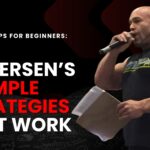We’ve all found ourselves in a slump, whether it’s in our role as a parent, at work, with our health and fitness, or even in our relationships. For Jon Andersen, a seasoned professional in the worlds of wrestling, bodybuilding, and strongman competitions, getting stuck is not unfamiliar territory. Like all of us, he has faced these moments, and in response, has developed five methods on how to overcome a slump to help break free and thrive.
Jon Andersen: A Career Defined by Strength
Before diving into Jon’s methods to combat slumps, it’s important to understand the kind of resilience and mental fortitude his career demands. Jon Andersen has etched his name in history as a formidable competitor in three grueling arenas: professional wrestling, bodybuilding, and strongman competitions. These fields require not only physical prowess but also an unparalleled dedication to mental and emotional strength. His journey through these high-demand sports has provided Jon with unique insights into overcoming the psychological hurdles that we all face.
Five Tools to Overcome Slumps
1. Embrace Immediate Action
The first tool Jon uses is taking immediate action. He believes that a slump often occurs when we overthink, procrastinate, and let excuses dominate our thoughts. Jon stresses that you don’t need to feel ready to take action. This mental barrier often prevents us from moving forward. Whether it’s something simple like going for a walk, making an uncomfortable phone call, or even doing household chores, taking immediate action breaks the cycle of stagnation and puts you back on the path to productivity.
2. Change Your Environment
Changing your surroundings can have a profound impact on your mental state. For Jon, it’s as simple as turning the chair around, stepping into a different room, or going outside. This shift not only alters your physical location but also triggers a mental shift, disrupting the patterns that keep you stuck.
3. Write It Down
When immediate action and environment change aren’t enough, writing down what’s bothering you can create clarity. Jon recommends penning your thoughts to identify the root cause of what has you stuck. This practice sometimes uncovers issues you weren’t even aware of, allowing you to address them directly and plan your next steps.
4. Address What You’re Avoiding
If writing reveals tasks or obligations you’ve been sidestepping, tackle them head-on. Jon suggests that sometimes it’s the avoidance of these small duties that contributes to feeling overwhelmed. By addressing these tasks, you not only clear mental space but also create a sense of accomplishment that propels you forward.
5. Engage in Movement
Lastly, movement is a powerful way to change your state. Whether it’s a workout or a simple walk, getting your blood flowing changes the chemicals your brain releases, enhancing your mood and clarity. Physical activity releases dopamine, serotonin, and oxytocin—natural mood enhancers that replace anxiety-inducing cortisol.
The Science Behind the Slump
Jon touches on the science supporting these methods, explaining how our brains struggle to simultaneously feel anxiety and gratitude. When stress manifests as cortisol, it paralyzes us with indecision and excuses. The antidote? Move your body, boost blood flow, and allow your brain to switch gears chemically into a more positive state.
Building a Life of Progress and Happiness
Jon Andersen’s methodology is not just theoretical. As someone who has reached the pinnacle of multiple careers that demand resilience and determination, he assures us that these tools are effective. They empower you to dismantle the barriers of a slump and set the stage for personal growth and happiness. Remember, Jon emphasizes that a few good years, built on consecutive good days, have the power to transform your life.
By implementing these five strategies, you can overcome the feeling of being stuck and pave the way toward achieving whatever success means to you. As Jon has shown through his illustrious career, physical and mental strength go hand in hand, reinforcing the belief that with the right toolkit, anyone can push through a slump and reclaim their path to happiness.









